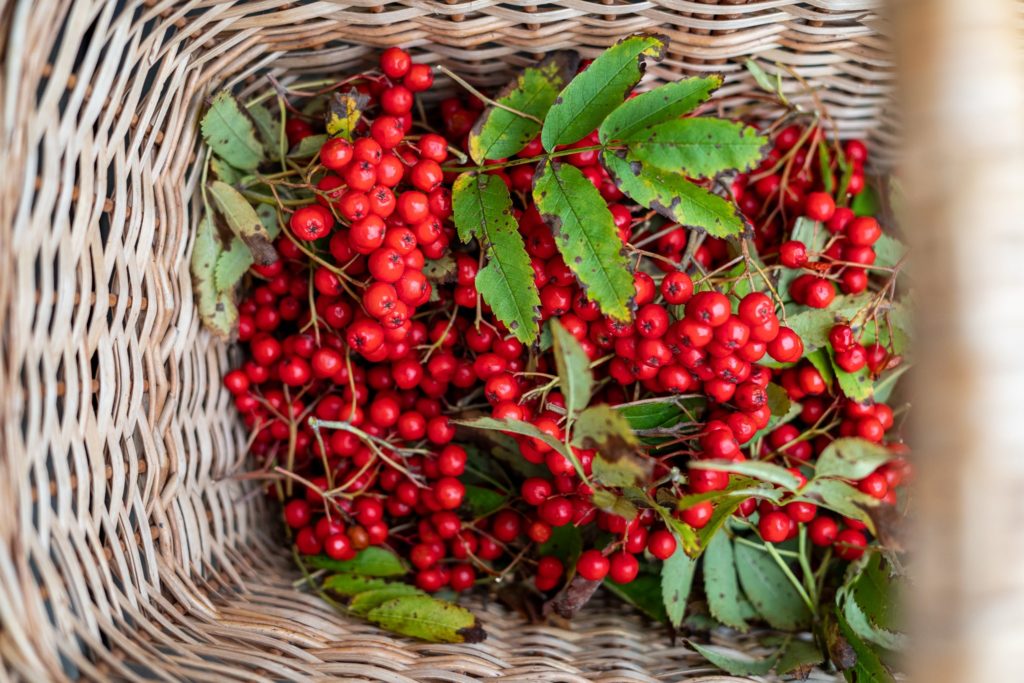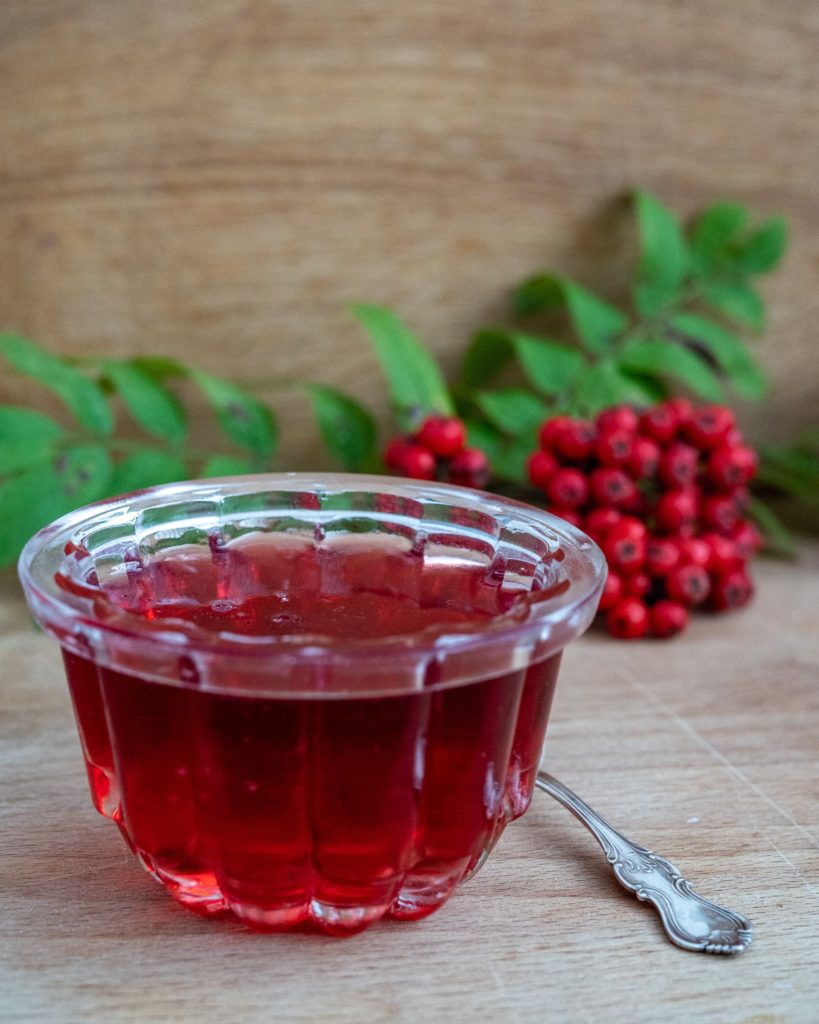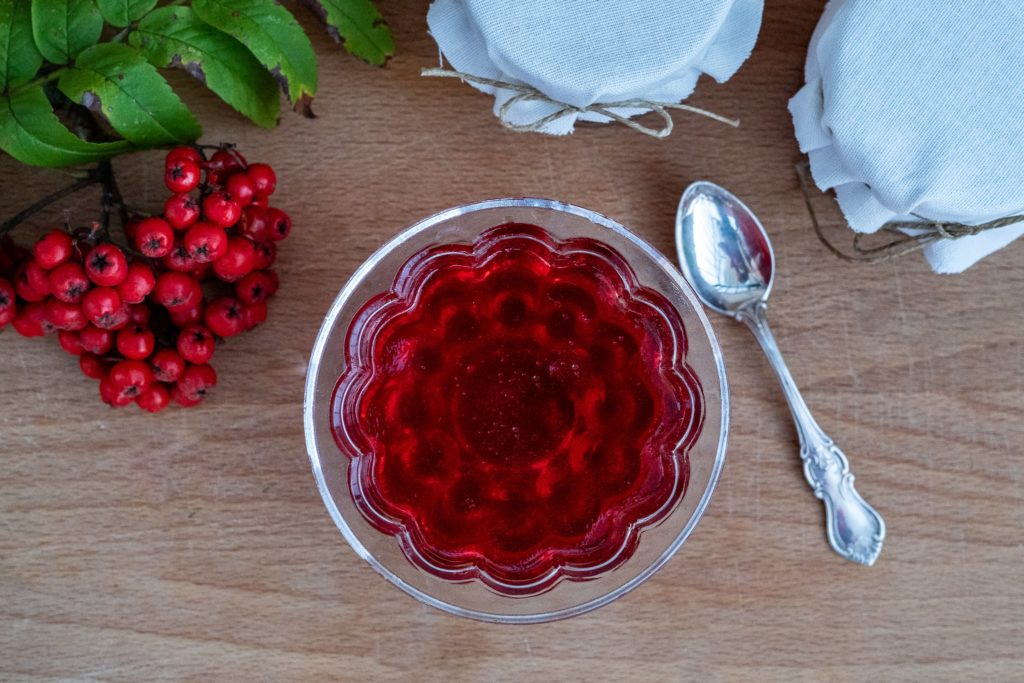If the tree is full of rowan berries, winter will be full of snow, according to an old saying. On such a berry-rich year, why not take a few of them for yourself to make rowanberry jelly?
I’ve been recommended to wait until the first frost to pick the rowan berries — apparently the berries become less tart and bitter. However, that comes with a certain degree of risk: birds. In 1966, the author and artist Gunnar Brusewitz complained in an humoristic essay in Svenska Dagbladet about the birds emptying the trees in his yard on fruits and berries. A helpful reader wrote all the way from Italy to give him advice on the best defence possible. The reader’s suggestion? To hang up salt-brined herrings in the trees! Brusewitz seemed to accept his fate, as he preferred eating the herrings instead…
Like Brusewitz, I prefer to eat the herring instead of using it as a bird repellant. You can leave most of the berries for the birds and still have more than enough for a flavorful jelly.

How to impress the French like Werner Vögli
Food writer Hiram once had a conversation with the chef Werner Vögli of restaurant Operakällaren, a big celebrity at the time. It turned out that Vögli had been asked to prepare the annual hunting dinner at a fancy château in France, Clos de Vougeot. He was the first foreign chef to get the honor. So, what did Vögli serve the discerning guests? 450 snow grouses. And, the thing that really impressed the guests? The rowan berry jelly! Apparently they hadn’t tasted it before, and it was especially appreciated that it played nicely with the Bourgogne wine they were drinking…

Turning rowan berries into jelly
“First class jelly should have a beautiful color, be clear and appropriately firm but not rubbery or hard.” — Stora Kokboken, 1948
The first time I made rowan berry jelly, I didn’t make it. I got a lot of rowan berry syrup instead. Defeated, it took me another ten years to muster up the enthusiasm to try again.
Sometimes, reading cookbooks like Stora kokboken makes me wonder what the mistresses of the old household schools would make of my cooking attempts.
But, let’s take a look at the advice to make sure you get a beautiful rowan berry jelly.
1. Finding the right consistency
It is all about pectin. If you serve the jelly straight from a jar, you don’t need to be as concerned about the consistency. You can use normal sugar when making it.
But, if you also bought cute old jelly glasses in a thrift shop and want a pyramid of perfectly shaped jelly? For a stiffer jelly, you want to take some precautions and do one or more of the following:
- Use jam sugar, or gelling sugar, instead of normal sugar.
- Let a diced apples boil with the rowan berries as you’re making the cordial, as apples are rich in pectin.
- Add pectin to the cordial as you add the sugar.
- Squeeze in some lemon juice.
It is also important that you don’t boil the rowan berries too long — only until they have softened — as the heat lowers the pectin amounts.
2. Getting a clear rowan berry jelly
First of all, you want to sort through the berries to remove any rotten ones. Then, you’ll rinse them well.
As you boil the berries, foam will form on the cordial’s surface. Remove it with a spoon. This is crucial if you want your jelly as clear as possible.

How to make rowanberry jelly
It is perfect for a nice roast beef, steak or game, but you can also use it to deepen the flavor of a gravy sauce or to dress roasted vegetables. Why not try rowan berry jelly instead of lingonberry jam with your meatballs?
You can use normal granulated sugar for this recipe, too. Just ensure that the jelly passes the gelling test before you pour it.
15 dl (6 cups) rowan berries
7 1/2 dl (3 cups) water
up to 6 1/2 (2 1/2 cups) gelling/jam sugar or normal granulated sugar
optional: a small apple
- Sterilize the jars and lids you want to use for the jelly, for example by boiling them in hot water or heating them up in the oven. Ideally, put a small plate or two in the fridge to use for the gelling test.
- Sort through and rinse the rowan berries. If using an apple, peel and slice it. Add the berries (and applie, if using) to a large pot together with the water and bring it to a boil. Lower the temperature to a gentle boil for 10-15 minutes with a lid, until the berries are softer. Remove the foam with a spoon. Don’t mush the berries — you’re just making a very sour cordial.
- Put a colander another pot, straining the berries and reserving the liquid. Again, don’t press the liquid out of the berries, but let them drain naturally. Measure the liquid. You want to use 90% sugar. For example, for 5 dl water I use 4 1/2 dl sugar. If you’re unsure of the exact amount, take “somewhat less” sugar than you have liquid. Bring the liquid to a boil, then whisk down the sugar, a little at a time.
- Keep on a lower boil for about 10-15 minutes, with a lid, or until the liquid passes the gelling test. To do the gelling test, pour a teaspoon of jelly on a small, preferably chilled plate and place it in the fridge. Test the consistency by drawing a line with the spoon through the jelly. If the line remains, the jelly has the right consistency. Otherwise, keep boiling it for another five minutes and try again.
- Once you have the right consistency, remove all the foam with a spoon and pour the jelly into the jars. Let it cool before putting the lid on. Store in a cool, dark place.
Suggestions
You can flavor the jelly in many different ways. Let a cinnamon stick boil with the berries, or why not a touch of rosemary or ginger?



Hi, thanks for the recipe! Haven’t made jelly for years, but now you triggered a strong desire to do so.
I read somewhere that the reason for waiting to pick the berries until after the first frost is that freezing increases the pectin content. If you want to make jelly before the birds have eaten all the berries, you can stick then in the freezer for a few days. I’ve tried that (but can’t remember if it worked).